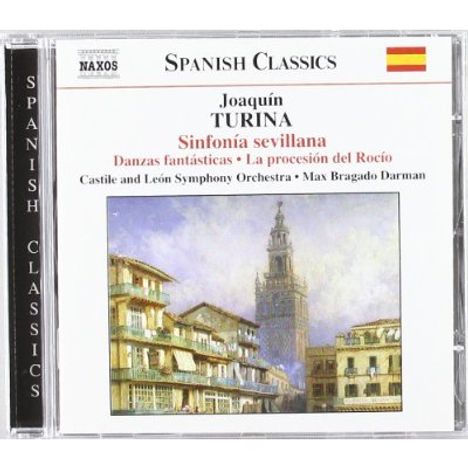Joaquin Turina: Sinfonia Sevillana op.23 auf CD
Sinfonia Sevillana op.23
Herkömmliche CD, die mit allen CD-Playern und Computerlaufwerken, aber auch mit den meisten SACD- oder Multiplayern abspielbar ist.
Lassen Sie sich über unseren eCourier benachrichtigen, falls das Produkt bestellt werden kann.
+Danzas fantasticas; Ritmos; La procesion del Rocio
- Künstler:
- Castile & Leon SO, Max Bragado-Darman
- Label:
- Naxos
- Aufnahmejahr ca.:
- 1994-1998
- UPC/EAN:
- 0747313595525
- Erscheinungstermin:
- 2.12.2002
- Serie:
- Naxos Spanish Classics
Ähnliche Artikel
Die Sinfonía sevillana ist Turinas orchestrales Meisterwerk und das erste bedeutende Werk dieser Art, das im zwanzigsten Jahrhundert in Spanien entstanden ist. 1920 geschrieben, überwiegt der Einfluss der Pariser Schola Cantorum durch einen idealisierten andalusischen Nationalismus, obwohl die verwendeten Rhythmen in Wirklichkeit der volkstümlichen Tradition entstammen. In Anbetracht dessen ist das Werk sehr flexibel in der Form und geschickt in der Orchestrierung. Die Titel der Sätze deuten auf die poetische Inspiration hin, die die Musik kennzeichnet. Der erste Satz, Panorama, bietet ein Gesamtbild; der zweite Satz, Por el río Guadalquivir (Am Fluss Guadalquivir), ist mit seinem poetischen Klima und seiner subtilen Orchestrierung vielleicht der vollendetste, während Fiesta en San Juan de Aznalfarache eine authentische Explosion von Farbe und Rhythmus bietet. Die Sinfonía brachte Turina den Preis Gran Casino de San Sebastián ein. Sie wurde am 11. September 1920 vom Madrider Symphonieorchester unter Enrique Fernández Arbós in Madrid uraufgeführt.
Turina schrieb schnell zwei Versionen seiner Danzas fantásticas, die intimere Klavierfassung und die Orchesterfassung, die am 30. Dezember 1919 uraufgeführt wurden. Letztere ist die bekannteste, mit der Farbe und der symphonischen Dimension, die sie der Tanzmusik einprägt. Die drei Sätze sind in der Partitur mit Zitaten aus dem Roman La orgía von José Más, dem Autor von Erzählungen, die in Sevilla spielen, versehen. Der erste, Exaltación, basiert auf einem aragonesischen Jota, obwohl er in etwas von größerer Tiefe umgewandelt wurde. Ensueño (Traum) erweckt den emotionalen Kern des Werkes zum Leben; es ist eine poetische Romanze, die andalusische Melodieelemente mit dem baskischen Rhythmus des Zorcico vermischt. Orgía ist eine brillante andalusische Farruca, deren melodische Wendungen an Flamenco erinnern. Die Danzas wurden am 13. Februar 1920 von den Madrider Philharmonikern unter Bartolomé Pérez Casas uraufgeführt.
The Sinfonía sevillana is Turina’s orchestral masterpiece and the first important work of this kind to be produced in Spain in the twentieth century. Written in 1920, the influence of the Paris Schola Cantorum predominates through an idealised Andalusian nationalism, although the rhythms used really come from popular tradition. Given that, the work is very flexible in form and skilful in its orchestration. The titles of the movements are indicative of the poetic inspiration that characterizes the music. The first movement, Panorama, offers a general picture; the second, Por el río Guadalquivir (By the River Guadalquivir), is possibly the most accomplished, with its poetic climate and subtle orchestration, while Fiesta en San Juan de Aznalfarache offers an authentic explosion of colour and rhythm. The Sinfonía won Turina the Gran Casino de San Sebastián prize. It was first performed in Madrid by the Madrid Symphony Orchestra under Enrique Fernández Arbós on 11th September 1920.
Turina quickly wrote two versions of his Danzas fantásticas, the more intimate piano version and the orchestral, first performed on 30th December 1919. This latter is the most widely known, with the colour and the symphonic dimension it stamps on the dance music. The three movements are given in the score with quotations from the novel La orgía by José Más, the author of stories set in Seville. The first, Exaltación, is based on an Aragonese jota, although transformed into something of greater profundity. Ensueño (Dream) brings to life the emotional heart of the work; it is a poetic romance that mingles Andalusian melodic elements with the Basque rhythm of the zorcico. Orgía is a brilliant Andalusian farruca, the melodic turns of which evoke flamenco. The Danzas were first performed by the Madrid Philharmonic under Bartolomé Pérez Casas on 13th February 1920.
Disk 1 von 1 (CD)
-
1 Sinfonia sevillana, Op. 23: Panorama
-
2 Sinfonia sevillana, Op. 23: Por el rio Guadalquivir
-
3 Sinfonia sevillana, Op. 23: Fiesta en San Juan de Aznalfarache
-
4 Danzas fantasticas, Op. 22 : Exaltacion
-
5 Danzas fantasticas, Op. 22 : Ensueno
-
6 Danzas fantasticas, Op. 22 : Orgia
-
7 Ritmos, Op. 43: Preludio - Danza lejana - Vals tragico - Garrotin - Intermedio - Danza exotica
-
8 La procesion del Rocio








